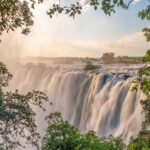Mozambique, located on the east coast of Africa, was for many years off-limits to tourists due the raging civil war, but 25 years on and visitors are rediscovering the country as a relatively unspoiled place to experience Africa’s unique natural beauty and vibrant culture.

Why You Should Visit Mozambique in 2020
If Mozambique isn’t already on your bucket lists of places to visit during your lifetime, then these ten experiences should convince you to put this wonderland at the top of your list.
Private Pristine Beaches
Mozambique has both a long Indian Ocean coastline and an archipelago of sandy islands, which means that there is no shortage of beaches here. Less touristy than its neighboring countries, here you can find a pristine white sandy beach that you can pretty much call your own. While the beach may be on the doorstep of your hotel, there is no jostling for deckchairs or competing for shady spots. If the beach is your favorite way to unwind, you will love Mozambique.
Check out the beaches near Xai-Xai, Praia do Tofo, Pemba, Barra and Quirimbas for the best sunbathing and swimming.
Unrivalled Diving and Snorkelling
Mozambique is home to the Quirimbas archipelago, the largest protected marine area in Africa. Therefore, it should be no surprise that Mozambique has some of the best diving and snorkeling anywhere in the world. Coastal forests and coral reefs provide the ideal homes for some spectacular sea life. You can see dolphins, whales, and turtles, and the waters are clear enough to see colorful fish from the boat, but there is something special about getting up close and personal in the water.
Some of the best diving can be found in the Bazaruto Archipelago, which is composed of five islands and is home to more than 2,000 different species of fish.
The Amazing Seafood
With so much gorgeous coastline, catch of the day really means fresh catch in Mozambique. While the country’s shellfish is considered some of the best in the world, it is how they prepare this delicacy that makes it irresistible. Mixing Portuguese and traditional African flavors, peri-peri style shrimp and Matata sea stew (clams in a king of peanut sauce) are both a must.
The breads and pastries are also delicious, and the local beer is also well worth trying. Try Laurentina Clara, a pale ale, and Laurentina preta, a dark lager.
Maputo Madness
If you are more interested in a party than a quiet beach, then Mozambique’s capital Maputo is calling to you! This is a bustling city with food vendors on every corner, which means that every street smells delicious. You can also hear marrabenta music and Afro-Latino tunes in busy but friendly clubs. The city’s markets are also a great place to grab some unique presents.
Start at the Mercado Central de Maputo for everything from fresh spices to antiques, and then head to the FEIMA for authentic handicrafts and intoxicating scents.
Authentic African Culture
While Portuguese colonialism has left its mark on the country, among other things the official language is Portuguese, a vast variety of ethnic groups occupy the area, speaking more than 40 different languages. Traditional cultural practices, passed down from generation to generation, still thrive in Mozambique, and the locals are happy to share their rich culture with visitors.
One of the most iconic practices in the Mapiko dance of the Makonde people and the “hopping dance” of the Makua.
Ancient Rock Art
Mozambique is not all beaches and savannas; you will also find lowland forests and afro-alpine grasslands. Head to the Chimanimani Mountains to discover yet another unique African habitat. The highest peak, Mount Binga, is 2436 meters above sea level, and there are lots of excellent trails to take on.
While exploring this mountainous region, you can also discover rock art created by our ancestors 10,000 years ago.
Gorongosa Safari
Before the Mozambique civil war, which lasted from the 1970s to 1990s, Gorongosa National Park received more visitors than South Africa and Zimbabwe combined. While animal numbers have diminished, this is still one of the best game viewing safaris on the content. It is also intriguing to discover the country’s work to repopulate and restore this natural treasure.
Look out for elephants, lions, zebras, and buffalo, as well as more than 300 different species of birds.
Uembje Lagoon
This lagoon, located not far from the country’s capital, is a vast water expanse 27 kilometers long and 8 kilometers wide separated from the Indian Ocean by a sand bar. The lagoon is hemmed in by white sandy beaches, and the calm waters are the ideal location for water sports and bird watching.
Look out for the striking are the pink flamingos that descend on the lagoon and turn the waters purple with their reflections.
The Lake of Stars
On the border between Mozambique and Malawi is Lake Niassa, also known as the lake of stars. It mixes pristine turquoise waters with white sandy beaches and is home to interesting sea life. Stay in the small town of Bilene where you can also enjoy local cuisine, music, and hospitality.
While there are a number of nice hotels in the area, the lights are low here, so it is also the ideal location to sit and look up at the stars.
Ilha de Mozambique
If you enjoy colonial architecture, make your way to the Ilha de Mozambique, which is home to both interesting architecture and compelling heritage. Originally established as a Muslin trading port, the Portuguese took over the city at the start of the 16th century. There you will find well-preserved colonial architecture, and the Fort of Sao Sebastiao, the oldest complete fort in sub-Saharan Africa, and the Green Mosque.
If this doesn’t satisfy your historic interest, head out to Ibo Island. Also, a Muslim trading port, later taken over by the Portuguese, there you will find the famous Fort of Sao Joao. Sadly, many homes on the island were destroyed by a cyclone in 2019.






